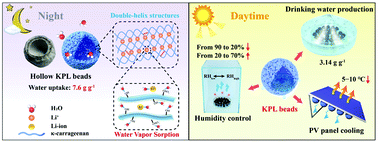Hygroscopic photothermal beads from marine polysaccharides: demonstration of efficient atmospheric water production, indoor humidity control and photovoltaic panel cooling†
Abstract
Atmospheric water is an abundant source of freshwater and it plays an important role in controlling the available water on land. Emerging atmospheric water generators (AWG) using desiccant materials enable active and efficient capture of atmospheric water even under low humidity conditions (i.e., relative humidity, RH below 40%). AWGs show strong potential for integrated technologies that benefit from solar-powered water desorption and reversible sorption–desorption cycles. Future development of solar-powered AWG systems is of particular interest for versatile energy-saving applications with minimized carbon footprints. Herein, a new sorbent-based AWG is developed via rational incorporation of marine polysaccharide, hygroscopic salt and photothermal polymer in a bead-like hollow structure, demonstrating reversible and durable water vapor harvesting. The desiccant beads attain high moisture sorption in a wide RH range of 35–90%, reaching maximum water uptake of 7.6 g g−1 under 90% RH and outperforming a majority of sorbent-based AWGs. The AWG-integrated system delivers 3.14 g g−1 of safe drinking water per night–day cycle, provides efficient humidity control in closed environments and boosts electricity production via photovoltaic cell cooling. This work provides a perspective on intelligent desiccant materials extracted from marine biomass and highlights their future opportunities in various energy-wise and sustainable applications.



 Please wait while we load your content...
Please wait while we load your content...